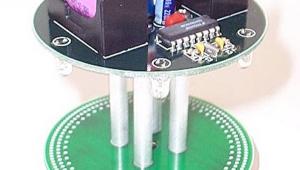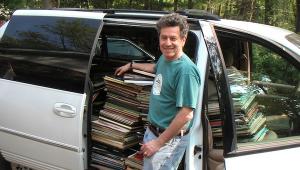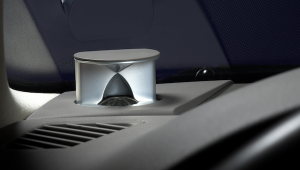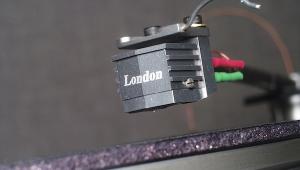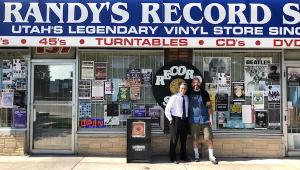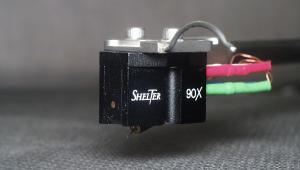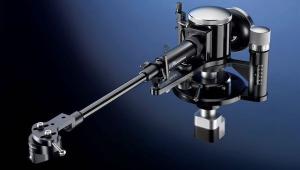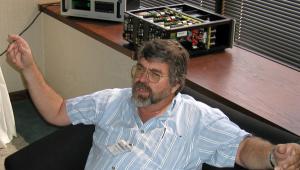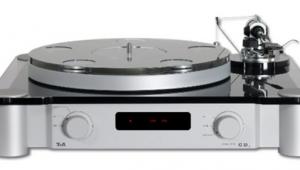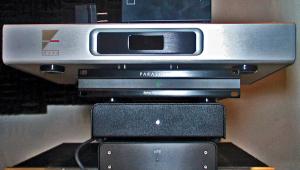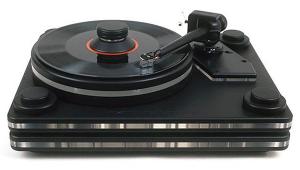Analog Corner #40

(Originally published in Stereophile, November 12th, 1998)
Have you noticed how the pace of things "going digital" has increased? There's no escaping it, and television's next. It'll take about 10 years, but then, like abandoned canals, the empty two-lane cement of Route 66, and overgrown railroad rights of way, the analog broadcast pathways will be discarded, handed back to the government for reuse in what will no doubt be a far less glamorous endeavor—garage-door opener or pocket-pager frequencies, perhaps.
Route 66 has made a tailfin'n'Elvis–based nostalgic comeback. So have steam trains, taking railroad buffs on daylong excursions over commuter rails. Last year I took one myself—and I enjoyed every soot-sprayed, purgatory-hot, steam-stinking, smoke-belching minute of it. (I hung out in one of the two open cars: standing room only, no glass in the windows.)
But analog television? Is anyone going to miss it? I doubt it—which is how most people felt about records with the introduction of the compact disc. Remember? People dumped their vinyl like carcinogens, and most haven't looked back with regret. Clearly, from our perspective, that's their loss.
How far back do you want to take it? There are people like Clark Johnsen in Boston who are still not only playing 78s, but rooting for them—writing about them not just as cool things, but as a format he's convinced can come back big if only people will listen! At least that's the way his writing on the subject comes across. No matter that a side lasts only three minutes—listen to it!
That's what LP fans must sound like to today's "pop and play" generation. That's how they'd take this column, probably. How could it be otherwise? Turntables are for scratching.
Okay, that's overstating things, and opening me up to nasty generational war letters from twentysomething readers. Turntables and records seem to be maintaining their hip currency even as sales of both have gone up, then stabilized in the past few years. As Nicholas Cage's character Goodspeed says in The Rock, while holding up a $600 sealed, mint pressing of Meet The Beatles he's just gotten in the mail, "These sound better."
Yes, we're rooting for vinyl LPs at a time when virtually everything else is going digital: DVD, television, telephones, answering machines, VCRs, camcorders, still cameras, medical gear, and, of course, audio. When either 24-bit/96kHz or DSD (or both) becomes an entrenched format, where will analog fans be left? I bet analog will still be the preferred recording medium of rock and jazz producers and engineers, and I figure most of us will continue to play what we've got on vinyl, but the new vinyl and vinyl reissue markets will wither as labels begin churning out their recordings in the new high-resolution format. For now, there are more new and reissued vinyl titles than 24/96 DADs (the acronym Classic Records is using). But that will change.
Speaking of "going digital," I just bought—are you ready for this?—a portable MiniDisc recorder: a Sony MZ-R50. I didn't buy it for music. Here's what happened: In one day I had interviews scheduled with Beatles producer George Martin and the great Ray Davies (of the Kinks, for you classical-music-only meatheads). The Martin interview went great, recorded on my GE microcassette recorder. If you remember the brouhaha I got into with a reader regarding the "reprocessed for stereo" songs on Magical Mystery Tour ("Analog Corner," June 1997; "Letters," September 1997), you can understand what a gas it was to ask the Beatles producer directly about those tracks and about "...which cufflinks producer George Martin was wearing for each session''—which, the letter-writer claimed (hyperbolically, of course), serious Beatle scholars can cite.
First, I was correct: Martin did not send Capitol the "reprocessed" tracks. Second, Martin did not wear cufflinks to either recording or mixing sessions. And now that he's retiring and can say what's on his mind, he had little good to say about Capitol's treatment of his recordings in general—and that's putting it mildly!
Then it was on to the Ray Davies portion of my day, and every interviewer's bad dream: the microcassette recorder screwed up. Fortunately, a few minutes into the interview, I did my customary double-check and heard the problem: intelligibility-destroying distortion. Why? I don't know. Something just happened, and it wasn't the batteries or the tape. But who cares? Given how much these things cost, they're disposable.
Luckily, I was able to borrow a Sony microcassette recorder from the publicist and continue the interview, which is in the current issue of The Tracking Angle. This experience convinced me to never again conduct an interview without a backup. Clearly, the ultracompact MiniDisc was the way to go: over two hours (in mono) of recording on one 21/2" plastic-encased disc, plus instant access.
So when my grand time with Raymond Douglas was up, I headed over to J&R Music World a few blocks away to buy a portable MD recorder. Guess what? They were out of stock. MD has gone from being a major-league disaster to a qualified and growing success.
How is that? Sony got smart and stopped pushing MiniDisc as a prerecorded portable music source, instead positioning it as a replacement for the cassette—and as a much more convenient portable music system than CD. Which it is. You can easily make your own compilations, and record over your mistakes almost instantly. You can also move and edit tracks as you wish after they're recorded. You can name your disc and every track on it, which is really good—when you go back and play it 10 years from now, you won't remember what half the songs were or who sang them. I'm going through that now with some early-'80s compilations I'd made and not documented. Haircut 100 or Flock of Seagulls? I wouldn't want to bet on it.
You can record and erase and record over the same disc so many times, you'll have worn out before your MDs do. The MZ-R50 easily fits in a pants or jacket pocket, and comes with a positively tubular multifunction clip-on remote control (including LCD readout), into which you plug your headphones.
But what about the sound? At first I didn't care—I was going to use the system for voice only. But once I got my hands on this compact little wonder, I got interested. After all, you can't take your LPs with you when you jog or fly on an airplane. Sure, some of you may opt for CD-R, but blanks (especially rewritable discs) are far more expensive and bulky, CDs usually skip when you jog or go over a bump in the car, and they're not nearly as versatile or flexible. And, as I'm sure you've discovered, they scratch. A 10-pack of 74-minute re-recordable MDs lists at $55.
The first few generations of MD recorders I heard sounded awful: dull, distant, limp. I wanted to hear "state-of-the-art" MD ca 1998, oxymoronic as that may sound. I now have Sony's JA20 ES MD recorder for review, which includes the latest version of Sony's digital compression scheme. I've done some CD-to-MD and LP-to-MD transfers, and no, it doesn't sound as good as the original source. But compared to Dolby-C metal cassette recorded on a Nakamichi BX-300, it's a tossup: the cassette has more "body" and noise, while the MD has greater clarity, dynamic range, speed stability, and blacker backgrounds. The MD doesn't sound hard or brittle. In fact, its sound is just the opposite—a bit soft, and in need of focus and firming-up. But, all in all, it sounds surprisingly rich and liquid, if still a bit limp.
I want good sound when I'm traveling, but I'll give up "the ultimate" for convenience's sake. So far, I find the tradeoff well worth it. I made an MD of my original British LP pressing of The Beatles—the "white" album—and it sounds much better than the Capitol CD, that's for sure. An Arthur Lee and Love compilation made from original gold-label Elektra pressings had me jogging contentedly through the late-summer heat—and knowing that I'd figuratively taken the Simon Yorke turntable to the park only added to the enjoyment.
True—a cassette or a DAT could do the same thing. But once you've experienced the MD's convenience and simplicity, there's no contest. Please don't hate me—listen for yourself first. Then hate me.
Back to analog!
A few weeks ago, while my wife was out of town at a dog show (Eno, one of our Bernese Mountain dogs, won "Best of Winners''), I used the opportunity to kick back and blast the stereo late into the night—a pretty stupid thing to do, since I was scheduled to be interviewed on camera for the History of Audio special on A&E the next day. I had just gotten the Ayre K-1 preamp broken in, and the system was sounding really sweet and detailed. But I was unprepared for what I heard on records I hadn't played in a long time.
I started about 9pm and didn't end until 3am, all the while pulling out familiar discs and ending up shouting to no one in particular, "I can't believe what I'm hearing! This is insane!" The low-level resolution, bass dynamics, focus—everything had reached a performance peak I'd not experienced before at home. I heard things on 25-year-old records I'd never heard before (on Little Feat's "Sailin' Shoes," there's a piano fill way in the background that I heard for the first time). I realized, as I headed for bed bleary-eyed, that I'd made a few recent changes to the system that might account for what I was hearing...but I didn't know which were responsible for what.
There was the preamp, which has an absolutely superb built-in phono section. The Immedia arm had just been rewired with a "six-nines" copper conduit in place of Discovery wire, I'd put Electra Glide Reference Glide Standard Fat Boy AC cords on the VTL 450s in addition to the even "fatter boy" already on the preamp, and I'd put large Walker Valid Points under the fairly heavy preamp and installed Walker's $1500 turntable motor drive.
Now that I've pulled the removable pieces out one at a time, I can report that, unfortunately, they all contributed to the final sound. Let's take them one at a time.
First, the Walker AC motor drive. The Yorke 'table doesn't come with a line conditioner. Yorke depends on an extremely heavy (24 lbs) platter, combined with weight distribution at its outer edge in conjunction with a very small, low-vibration, 3W motor driven at 90V via a transformer, for both speed accuracy and smooth drive. And it works well. But adding Walker's motor drive made a noticeable improvement in bass dynamics, image solidity and focus, and especially in transient speed and purity—not earthshaking, but not subtle either.
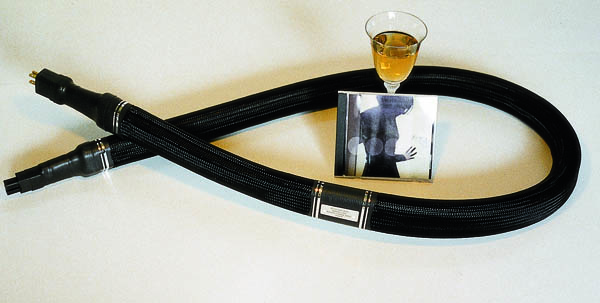
According to Walker, the building blocks of the conditioner consist of a transformer that isolates and filters the incoming AC, two sets of ultra-high-speed Motorola diodes that convert AC to DC, a sinewave generator and wave-shaping circuit that produce the "smoothest possible drive signal," a 25W power amplifier, and, finally, another isolation transformer to prevent any residual motor hash from coming back down the line. The signal is thus quadruple-isolated from the wall. Walker says the unit can be used with any turntable driven by an AC motor, including those from VPI, Basis, Clearaudio, Well Tempered, etc. For 45rpm on the Well Tempered, a low-pass filter must be removed.
You dial in exact speeds for both 33rpm and 45rpm via internally mounted pots. Speed change is accomplished via the flick of a switch. Walker is toying with the idea of making the pots more accessible, along with adding a toggle switch to change the motor phase. (There's a 50% chance that the motor is out of phase with the drive.) Currently, if you want to try this little tweak, you have to cross the two output wires (unplug the unit first!) and listen each way. At $1500, Walker's motor drive is clearly meant for top-shelf 'tables only. It's expensive icing—no point in putting it atop a Betty Crocker cake.
But there's one ridiculous caveat: I realized, long after I'd removed the motor drive from the system and done my sonic comparisons, that I'd been using a pair of high-quality Yamamura Quantum AC cords—one between the wall and the motor drive, one between the drive and the Yorke voltage step-down transformer's IEC jack. Switching to standard-issue AC cords made a depressingly? "softening" sonic difference. Even leaving one in the line had a negative effect. Again, I'm not talking "earthshaking" differences, but if you're using a single high-quality cord for your motor, be prepared to add another for the $1500 drive if you wish to derive the full benefit. On the other hand, if your motor has a hardwired cord, no problem.
Next, I removed the three 2" Valid Points from beneath the Ayre K-1. These are heavy brass-alloy-and-lead cones, the points of which rest atop resin-filled brass-ringed "tuning discs." Two more tuning discs sit atop the preamp to damp the top cover. You place them where tapping the cover yields the least ringing. I had three of the smaller (11/2") cones under the Ayre's power supply.
Resting on the Symposium Acoustics board via its four rubbery feet, the Ayre K-1 still sounded extremely well organized and harmonically rich, but the deep bass wasn't quite as tight and focused and the blackness between instruments wasn't quite as dark. I know I'm entering dangerous J-10 territory here, but sometimes that's where a man's gotta go. Three large cones plus five discs cost $260. Other sets are priced accordingly. Definitely worth checking out—and Walker will refund your money if you're not satisfied. (You must return the set within 30 days in original condition.)
Then it was on to the Electra Glide AC cables. I replaced them with some generic black cords—the kind electronics manufacturers supply. Logic dictates that these things shouldn't make a difference, doesn't it? The power travels from the generating plant all the way to your home on cable that's not "six-nines" copper, not ceramic-coated with "space age" materials, doesn't have Teflon dielectric, and doesn't have conductors arranged around some mystical geometric pattern. So why does replacing those few feet between amps and wall and preamp and wall make such a big difference? I've heard the theories; more important, I've heard the difference.
I've been hedging on this, but now that I've had these Electra Glide Reference Glide AC cords on the amps and preamp, and removed them cold turkey and listened again with generic cords, it's not at all subtle: they increase blackness, focus, bass solidity, detail, and dynamics.
With the cords, cones, and motor drive out of the system, it still sounded great; I attribute much of the improvement to the Ayre K-1 preamp. But with everything back in the system, I can "see" much farther into the soundstage, low-level detail resolution is greatly enhanced, and the entire system just "pops" and snaps with "live" excitement.
Of all the accessories I added, the cables made the biggest overall difference. Made with light, flat ribbon-copper technology and using space-age ceramic materials, they are hideously expensive—about $1200 each. But try them and you'll want them.
The Mailbag
I've gotten nothing but positive feedback—especially from Koetsu owners—concerning the very reasonably priced stylus-replacement services offered by Expert Stylus Company in the UK, headed by Wyndham Hodgson. A reader recently sent me an informative article on the company, originally published in Hi-Fi News & Record Review (July 1994). This is no "cottage industry" company. According to the article, Expert polishes diamonds for lenses and lasers used in scientific research, and even supplies diamonds to mints around the world for use in making the plates from which paper currency is printed.
The same reader also sent me a sample of a sticky green compound that Expert sends to customers who use certain cartridge brands (in this case, a Garrott P-77). Expert's note, included with the material, claims that chemicals in some stylus-cleaning liquids can destroy the bonding material that fixes the diamond to the cantilever in certain brands. Expert does not sell this material, which you very carefully and gently press onto the stylus tip, embedding it into the material, and then just as carefully remove, leaving no residue on the tip. Tricky to use, but it works well. Maybe Expert should sell it to the general public.
For owners of Rega Planar arms and turntables, Primyl Vinyl—a record-collector newsletter—published an informative and very useful article on modifying Rega arms and 'tables in its May/June 1998 issue. The article includes how to rewire the RB300 arm, a solution for the Grado/Rega hum problem (Co-Netic AA flexible EMI barrier foil, which you can purchase from the Magnetic Shield Corp., 630-766-7800), and other performance tips and sources for parts. The story is based on one originally seen online at Hi-Fi Playground. I recommend both to any Rega owner seeking to improve the performance of an already fine piece of affordable hi-fi.
Finally, a new Virgin Megastore is opening in Union Square in downtown Manhattan. Its print ads read, "Do you spin a bike at Crunch [a health club] and indie vinyl at home?" We'll be visiting to see if Virgin puts its vinyl where its ad campaign is!

